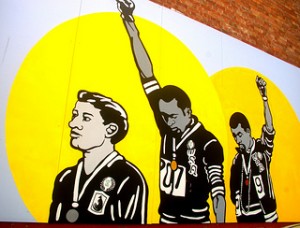Why The Most Famous Image In Olympic History Matters To Latinos

 By Cristopher Rubio, Being Latino
By Cristopher Rubio, Being Latino
A brief look into the history of the modern Olympic games provides us with some incredible moments, but perhaps no single image carries greater weight, or more significance, than that of Tommie Smith and John Carlos during the 1968 Summer Olympics games in Mexico City.
The 1960s was a turbulent decade to say the least. The U.S. entered the Vietnam War, the Civil Rights Movement was in full swing, and both Dr. Martin Luther King Jr. and Robert F. Kennedy were assassinated just a few months before the Olympics began.
Smith and Carlos knew that they had to make a statement to express their views on the state of affairs in the country. They originally planned to boycott the Olympic games altogether, but when they agreed to participate, they knew their statement could be made during the Men’s 200 Meter race. Of course, they also knew they had to win.
Smith ended up taking the gold medal (and setting a world record), with Carlos winning the Bronze. The stage was now set for a statement.
They walked to the medal stand without shoes, symbolizing poverty. On their hands, they wore a black glove, meant to symbolize power and strength. As the national anthem played, they bowed their heads and raised their fists in the air, not only the symbol for Black power, but for human rights in general.
Their courageous gesture was met with immediate backlash. The International Olympic Committee forced Smith and Carlos off the Olympic team, and the pair was swiftly sent home. Back home, it wasn’t a warm reception either.
Today, the pair is celebrated for the statement they made over four decades ago. A statue was built in 2003 to honor them on the campus of San Diego State (their alma mater).
If you’ve heard this story many times before, here’s another interesting piece of information: John Carlos is Latino. I was surprised to learn that he is Cuban (mother’s side) a few months ago. So you might be thinking, “Does this change what he did in any way? Do you now view him differently just because you found out he is Latino?”
The answer to both questions is ‘No,’ but I do believe this is relevant for many reasons. For one, it’s just another example of how similar the struggle has been for people of color (Blacks and Latinos in this case). Granted, I don’t fully know how Carlos identifies, but it’s not up to me to determine if he’s “Latino enough.”
But I feel it’s also relevant because it shows that Latinos have had a place in this country’s history for longer than we may think. There are the events and people we know about (like Roberto Clemente) and the things we don’t talk about enough (i. e. Latino influence in the formation of Hip-Hop); this is an example of something we don’t know and talk about enough. And we should, not just because he’s Latino, but because both men risked everything to make this country a better place for all of us.
This article was first published in Being Latino.
To see the original 1968 Olympic protest photo, click HERE.
Cris was born in McAllen, Texas to a Mexican mother and Salvadoran father. A well-rounded student and basketball player in high school, Cris attended the University of Texas at Austin. As an undergrad, Cris was highly involved with various student organizations in the Latino community, including Lambda Theta Phi Latin Fraternity, Inc. He credits many of the people he met during this time with helping him realize his passion for equality and social justice. After graduating with a B. A. in Mathematics, Cris was selected as a 2007 Teach for America Corps member in Atlanta, Georgia.
[Photo by RaeAllen]

